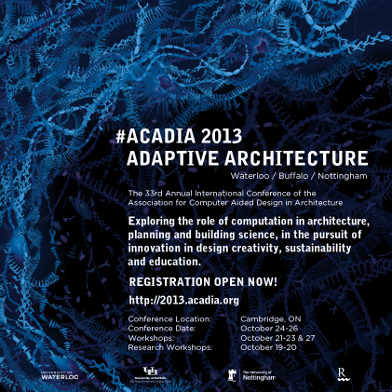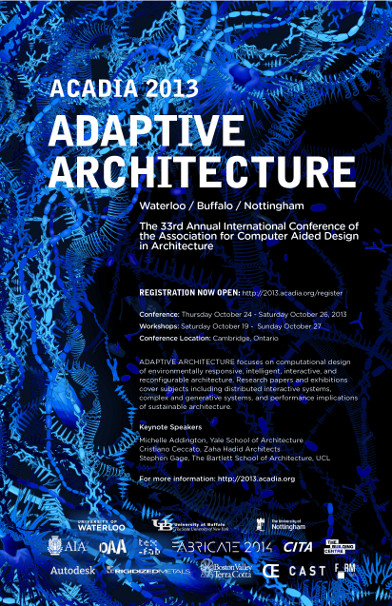ABOUT
Contact
acadia.conference.2013.chairs@gmail.com
About ACADIA
ACADIA was formed for the purpose of facilitating communication and critical thinking regarding the use of computers in architecture, planning, and building science. The organization is committed to the research and development of computational methods that enhance design creativity, and that aim at contributing to the construction of humane physical environments. A particular focus is education and the software, hardware and pedagogy involved in education. Visit the main ACADIA website for more information.
Media Downloads
2013 ACADIA Focus
Adaptation is a quality of living systems. Adaptation can include evolution in response to new conditions, and it can also involve resistance to change. How might we more precisely simulate, visualize and represent the dynamics of open systems? What are useful models for emulating living systems and ecologies? The contemporary information environment of distributed and mobile computing provides opportunities to develop new and subtle relationships between people and the built environment. How might architecture better anticipate and adapt to user and social needs? These emerging ecologies increase architecture's capacity to be more responsive to its inhabitants as well as the natural environment. How might passive, low energy systems offer alternatives to power consuming responsive systems? What tools, materials and assemblies might we use in designing for adaptation? What new industrial and manufacturing possibilities might emerge?
Adaptive Architecture will focus on the computational design of environmentally responsive, intelligent, interactive, and reconfigurable architecture. Research papers and exhibition submissions are invited across a range of topic areas that include distributed interactive systems, complex and generative systems, standards of passive and active design, and performance implications of sustainable architecture.
Advanced computational design methods, building information modeling, and digital fabrication workshops will precede the conference event. Full research papers, short work-in-progress papers, and juried design and research posters will be presented. Work-in-progress presentations will be enriched by mentoring and structured feedback. Student submissions are especially encouraged, supported by an award program and travel and accommodation subsidies. The event will be enriched by curated projects including publications on emerging teaching models for complex systems and adaptive architecture, exhibition of architectural prototypes, and installations by visiting student teams.
The ACADIA event builds on the first Adaptive Architecture Conference held at the Building Centre, London, Spring 2011. 2013 Co-Chairs are Philip Beesley (University of Waterloo), Omar Khan (University at Buffalo, SUNY) and Michael Stacey (University of Nottingham).
For more information please e-mail:
acadia.conference.2013.chairs@gmail.com
Who Can Participate
Specialized researchers, practitioners, students, and members of the public interested in the computational design of architecture are welcome to participate. In addition to architecture and urban design, the gathering will be of general interest to the disciplines of science and art, engineering and design.
ACADIA 2013 Topics
Research presentations will focus on the role of computation in architecture, planning, and building science, and that pursue innovation in design creativity, sustainability, and education. Paper submissions can include the following topics:
TOOLS and INTERFACES
- Simulation, collaboration and generative tools
- Human/Computer Interfaces
NEXT GENERATION TECHNOLOGY
- Responsive environments; distributed controls, sensing, actuation and feedback
- Digital fabrication and robotic craft
- Hybrid structural systems
- Synthetic construction: composite materials, smart assemblies, material analysis
COMPLEX SYSTEMS
- Complex systems in design; emergent and self-organizing systems
- Environmental adaptation, passive systems
- Energy and performance modeling, structural analysis
SOCIAL FORMS
- Participatory design
- Social media and gaming
THEORY AND CULTURE
- Social and cultural implications of computation and cybernetics
- Contemporary and historical approaches to adaptation
TEACHING
- Computational design methodology
- Curriculum models
Organizers
Conference Chairs
Philip Beesley, Professor
University of Waterloo, Philip Beesley Architect Inc. (link)
Omar Khan, Associate Professor and Chair
University at Buffalo, SUNY, Center for Architecture and Situated Technologies (link)
Michael Stacey, Chair in Architecture and Director of Architecture
University of Nottingham (link)
Unconventional Computing: Design Methods for Adaptive Architecture
Rachel Armstrong
Simone Ferracina
Jim McClelland
Waterloo Coordination
Sue Balint
Jonathan Gotfryd
Connor O'Grady
Sheida Shahi
May Wu
Elisabeth van Overbeeke
Mingyi Zhou
Floating Tree, Kristie Taylor-Muise - Web Design
Buffalo Coordination
Albis Del Barrio Batista
Michael Lempert
Prototyping Architecture Publication and Exhibition
Laura Gaskell
Jenny Grewcock
Alex Lazarou
Ben Stanforth
Publications Editing
Elizabeth Antczak
Petra Bogias
Jessica Craig
Claire Crighton
Maighdlyn Hadley
Miriam Ho
Andrea Hunniford
Magda Milosz
Amrit Phull
Iggy So
Miriam Wierzchoslawska
Publications Production
Amal Dirie
Lisa Huang
Faisal Kubba
Sean Yang
Peer Review Board
Sean Ahlquist
University of Michigan
Chandler Ahrens
Washington University
Philip Beesley
University of Waterloo
Brad Bell
University of Texas Arlington
David Benjamin
The Living
Chris Beorkrem
University of North Caroline Charlotte
Adrian Blackwell
University of Waterloo
Anne Bordeleau
University of Waterloo
Gail Borden
University of Southern California, School of Architecture; Borden Partnership
Nicholas Bruscia
University at Buffalo, SUNY
Mark Cabrinha
California Polytechnic State University, Architecture
Bradley Cantrell
LSU School of Landscape Architecture
David Celento
DigiFabLab
Nancy Cheng
University of Oregon
John Chilton
University of Nottingham
Mike Christenson
North Dakota State University
Dana Cupkova
Carnegie Mellon University, School of Architecture
Susannah Dickinson
University of Arizona
Tomás Dorta
Université de Montréal, School of Industrial Design
Nick Dunn
University of Manchester, School of Architecture
Jefferson Ellinger
University of North Caroline Charlotte
Elizabeth English
University of Waterloo
Michael Fox
California State Polytechnic University Pomona
Stephen Gage
The Bartlett - University College London
Laura Garofalo
University at Buffalo, SUNY
Jordan Geiger
University at Buffalo, SUNY
David Gerber
University of Southern California
Ruairi Glynn
The Bartlett - University College London
Marcelyn Gow
Southern California Institute of Architecture
Fabio Gramazio
ETH Zurich
Maria Paz Gutierrez
University of California Berkeley
Jonathan Hale
University of Nottingham
Timothy Hemsath
University of Nebraska-Lincoln
Joyce Hwang
University at Buffalo, SUNY
Maciej Kaczynski
University of Michigan
Karen Kensek
University of Southern California
Omar Khan
University at Buffalo, SUNY
Axel Kilian
Princeton University
Kevin Klinger
Ball State University
Branko Kolarevic
University of Calgary
Robert Krawczyk
Illinois Institute of Technology, Architecture
Andrew Kudless
California College of the Arts
Brian Lilley
Dalhousie University
Pablo Lorenzo-Eiroa
The Cooper Union
Gregory Luhan
University of Kentucky
Steven Mankouche
University of Michigan
Scott Marble
Columbia University, GSAPP
Adam Marcus
University of Minnesota, School of Architecture
Wes Mcgee
University of Michigan
Achim Menges
University of Stuttgart, Institute for Computational Design
Volker Mueller
Bentley Systems
Terri Meyer Boake
University of Waterloo
Oliver Neumann
University of British Columbia, School of Architecture and Landscape Architecture
Chantelle Niblock
University of Nottingham
Kat Park
SOM
Vera Parlac
University of Calgary
Andrew Payne
Harvard University
David Pigram
University of Technology, Sydney
Georg Rafailidis
University at Buffalo, SUNY
Dereck Revington
University of Waterloo
Michael Rogers
University at Buffalo, SUNY
Christopher Romano
University at Buffalo, SUNY
Val Rynnimeri
University of Waterloo
Jenny Sabin
Cornell University
Axel Schmitzberger
California State Polytechnic University Pomona
Holger Schnädelbach
University of Nottingham
Bob Sheil
The Bartlett - University College London
Lola Sheppard
University of Waterloo
Michael Silver
University at Buffalo, SUNY
Ryszard Sliwka
University of Waterloo
Jin Young Song
University at Buffalo, SUNY
Aaron Sprecher
McGill University
Michael Stacey
University of Nottingham
Tristan Sterk
The Office for Robotic Architectural Media; Bureau for Responsive Architecture
Martin Tamke
Center for Information Technology and Architecture
Aron Temkin
Norwich University
Peter Testa
Southern California Institute of Architecture
Geoffrey Thun
University of Michigan
Skylar Tibbits
Self-Assembly Lab
Therese Tierney
University of Illinois
Robert Jan van Pelt
University of Waterloo
Kathy Velikov
University of Michigan; RVTR
Tom Verebes
The University of Hong Kong
Joshua Vermillion
Ball State University
Andrew Vrana
University of Houston; TEX-FAB
Glenn Wilcox
University of Michigan
Michael Williams
University at Buffalo, SUNY
Robert Woodbury
Simon Fraser University
Wei Yan
Texas A&M University
Peter Yeadon
Rhode Island School of Design
Shai Yeshayahu
Southern Illinois University Carbondale

